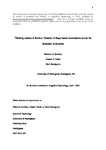Thinking outside of the box: Transfer of shape-based reorientation across the boundary of an arena
| dc.contributor.author | Buckley, MG | |
| dc.contributor.author | Smith, Alastair | |
| dc.contributor.author | Haselgrove, M | |
| dc.date.accessioned | 2017-12-06T10:44:42Z | |
| dc.date.available | 2017-12-06T10:44:42Z | |
| dc.date.issued | 2016-05-28 | |
| dc.identifier.issn | 0010-0285 | |
| dc.identifier.issn | 1095-5623 | |
| dc.identifier.uri | http://hdl.handle.net/10026.1/10373 | |
| dc.description | publisher: Elsevier articletitle: Thinking outside of the box: Transfer of shape-based reorientation across the boundary of an arena journaltitle: Cognitive Psychology articlelink: http://dx.doi.org/10.1016/j.cogpsych.2016.04.001 content_type: article copyright: © 2016 The Author(s). Published by Elsevier Inc. | |
| dc.description.abstract |
The way in which human and non-human animals represent the shape of their environments remains a contentious issue. According to local theories of shape learning, organisms encode the local geometric features of the environment that signal a goal location. In contrast, global theories of shape learning suggest that organisms encode the overall shape of the environment. There is, however, a surprising lack of evidence to support this latter claim, despite the fact that common behaviours seem to require encoding of the global-shape of an environment. We tested one such behaviour in 5 experiments, in which human participants were trained to navigate to a hidden goal on one side of a virtual arena (e.g. the inside) before being required to find the same point on the alternative side (e.g. the outside). Participants navigated to the appropriate goal location, both when inside and outside the virtual arena, but only when the shape of the arena remained the same between training and test (Experiments 1a and 1b). When the arena shape was transformed between these stages, participants were lost (Experiments 2a and 2b). When training and testing was conducted on the outside of two different-shaped arenas that shared local geometric cues participants once again explored the appropriate goal location (Experiment 3). These results provide core evidence that humans encode a global representation of the overall shape of the environments in, or around, which they navigate. | |
| dc.format.extent | 53-87 | |
| dc.format.medium | Print-Electronic | |
| dc.language | en | |
| dc.language.iso | en | |
| dc.publisher | Elsevier BV | |
| dc.subject | Geometric module | |
| dc.subject | Spatial learning | |
| dc.subject | Navigation | |
| dc.subject | Global | |
| dc.subject | Local | |
| dc.subject | Reorientation | |
| dc.title | Thinking outside of the box: Transfer of shape-based reorientation across the boundary of an arena | |
| dc.type | journal-article | |
| dc.type | Journal Article | |
| dc.type | Research Support, Non-U.S. Gov't | |
| plymouth.author-url | https://www.webofscience.com/api/gateway?GWVersion=2&SrcApp=PARTNER_APP&SrcAuth=LinksAMR&KeyUT=WOS:000378661200003&DestLinkType=FullRecord&DestApp=ALL_WOS&UsrCustomerID=11bb513d99f797142bcfeffcc58ea008 | |
| plymouth.volume | 87 | |
| plymouth.publication-status | Published | |
| plymouth.journal | Cognitive Psychology | |
| dc.identifier.doi | 10.1016/j.cogpsych.2016.04.001 | |
| plymouth.organisational-group | /Plymouth | |
| plymouth.organisational-group | /Plymouth/Faculty of Health | |
| plymouth.organisational-group | /Plymouth/Faculty of Health/School of Psychology | |
| plymouth.organisational-group | /Plymouth/REF 2021 Researchers by UoA | |
| plymouth.organisational-group | /Plymouth/REF 2021 Researchers by UoA/UoA04 Psychology, Psychiatry and Neuroscience | |
| plymouth.organisational-group | /Plymouth/Users by role | |
| plymouth.organisational-group | /Plymouth/Users by role/Academics | |
| plymouth.organisational-group | /Plymouth/Users by role/Researchers in ResearchFish submission | |
| dc.publisher.place | Netherlands | |
| dcterms.dateAccepted | 2016-04-20 | |
| dc.identifier.eissn | 1095-5623 | |
| dc.rights.embargoperiod | Not known | |
| rioxxterms.versionofrecord | 10.1016/j.cogpsych.2016.04.001 | |
| rioxxterms.licenseref.uri | http://www.rioxx.net/licenses/all-rights-reserved | |
| rioxxterms.licenseref.startdate | 2016-05-28 | |
| rioxxterms.type | Journal Article/Review |


